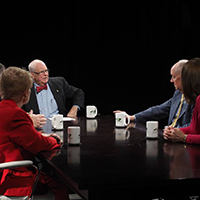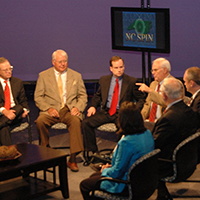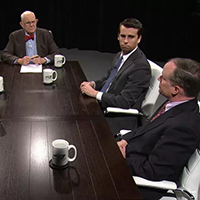A telling defense of a woefully inadequate budget
Published September 17, 2015
by Chris Fitzsimon, NC Policy Watch and NC SPIN panelist, September 16, 2015.
One of the most telling things about the woeful budget agreement crafted in secret and unveiled this week by legislative leaders is how they defend it, spending as much time boasting about things they didn’t cut as they do talking about new investments they made.
The headlines from the first few days of the budget coverage made the same point, emphasizing that the budget “protects teacher assistants and driver’s ed,” or “restores education items and tax credits.”
You’d think the state was still struggling with the worst of the Great Recession with state revenues plummeting and lawmakers scrambling to keep schools open.
The opposite is true of course. The recession is over and state revenues have rebounded but the Republican majority in the House and Senate has decided not to reinvest in education and human services that were slashed during the downturn, but instead to cut taxes again, giving still more breaks to millionaires and out-of-state corporations that received huge windfalls in the 2013 tax changes.
It is true that the budget fully funds teacher assistants at least year’s level, but thanks to cuts in recent sessions, there are 7,000 fewer TAs in classrooms across the state than there were in 2008. Not cutting more hardly seems worthy of a celebration.
Lawmakers boasting about increasing overall funding for education never mention that the vast majority of the new money pays for increased enrollment at public schools and universities, keeping the TAs and funding driver’s ed for one more year.
Those enrollment and inflationary increases used to part of what’s called the base budget. It was assumed that they would be funded but lawmakers changed the budget process so they could claim credit for meeting their basic funding responsibilities and keeping state services at the same level as the year before.
Even with the “new funding,” there are still more cuts in education, another big reduction for the university system, another round of cuts for the Department of Public Instruction that many rural school systems rely on for support.
In spite of all the bluster about raising teacher pay, many veteran teachers will receive no salary increase at all, only a one-time $750 bonus, which comes to about $62 a month before taxes.
The bonus is less than half the ongoing $1,800 break millionaires will receive from the tax changes, a contrast that perfectly illustrates the priorities of the folks currently running things in Raleigh.
State employees will receive the same small bonus. Retired state workers will get nothing, no cost of living increase at all.
Overall the budget leaves state spending as a share of the economy down for the seventh consecutive year and at a forty-year low. It’s hard to make progress without supporting the people and institutions that make progress possible.
There’s plenty of ideology spread through the 400 plus pages of the budget document too, more funding for the completely unaccountable private school voucher scheme while state support is ended for the Hunt Institute for Educational Leadership simply because of its association with former governor and prominent Democrat Jim Hunt.
There’s money set aside to transition the state’s Medicaid program to a for-profit managed care system that has failed in other states but no mention of Medicaid expansion that would provide health care for coverage for 500,000 low-income adults with the federal government picking up most of the tab.
Legislative leaders claim the spending plan is all about economic development, that more tax cuts will create more jobs, but there’s little evidence of that. The budget will undoubtedly cost the state jobs though, with the elimination of the highly successful renewable energy tax credit and the credit for research and development.
Lawmakers did renew the historic preservation tax credit, though at a lower level than last year.
There’s plenty more of course. There’s no way to cover everything in a 400-plus-page budget crafted in secret that spends $21.74 billion dollars and makes dozens of significant policy decisions.
News stories can’t do it either. Legislative leaders know that. That’s why they stuff so many important provisions into the massive budget document, many of which have never been seen by the public or the media, not to mention rank and file lawmakers themselves.
This absurdly non-transparent process is part of this year’s budget story. Most members of the Senate first saw the massive budget bill online at just before midnight Monday—if they were still awake—and were forced to vote on it just after 2:00 Tuesday afternoon.
There’s no way that most Senators knew what they were considering. Claims by Senate President Pro Tem Phil Berger that the provisions had been around for months were proven false Tuesday morning when the News & Observer reported that the budget includes a never before seen provision that cripples plans for a light-rail line between Durham and Chapel Hill.
Legislative leaders don’t like mass transit but would rather not make their case in public, in a democratic process where everyone can hear the debate and their constituents can have a say. The lawmakers will decide transportation policy in secret and use a budget provision to implement it.
That’s why they would rather not give people time to read the budget. Who knows how many more big policy decisions have been made in the backrooms and slipped into the spending plan?
The process is broken and the budget is inadequate, despite the blizzard of talking points and press releases defending it.
Not making more drastic cuts doesn’t mean making the overdue investments the state needs. Not doing worse is not doing better and not moving backwards as fast is not moving forward.
Giving more tax cuts to the folks at the top while claiming credit for not slashing state services and hurting the folks at the bottom more is a sad summary of the long overdue budget.
But that’s exactly what this year’s budget does, no matter how hard legislative leaders try to convince us otherwise.
September 17, 2015 at 11:08 am
Richard L Bunce says:
Investing in education... sure it does... the Education Voucher program receives a substantial increase to accommodate more of, but not nearly all, parent demand.







